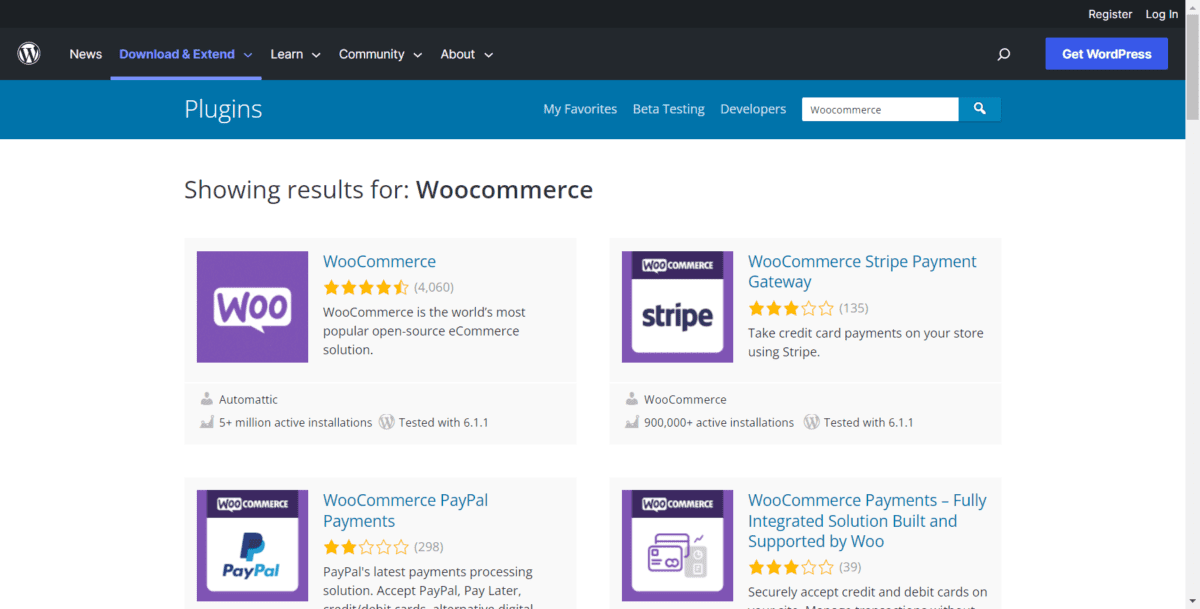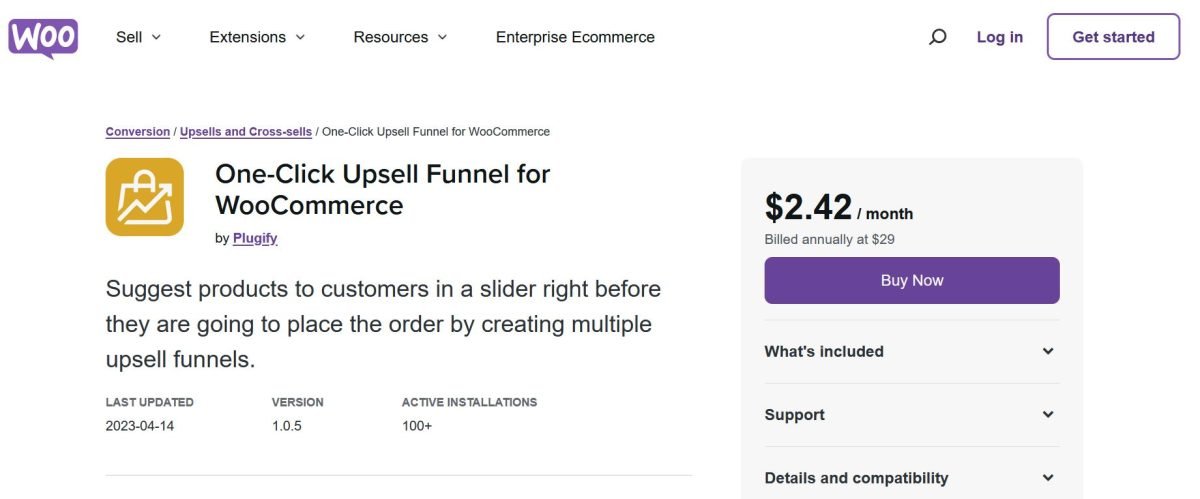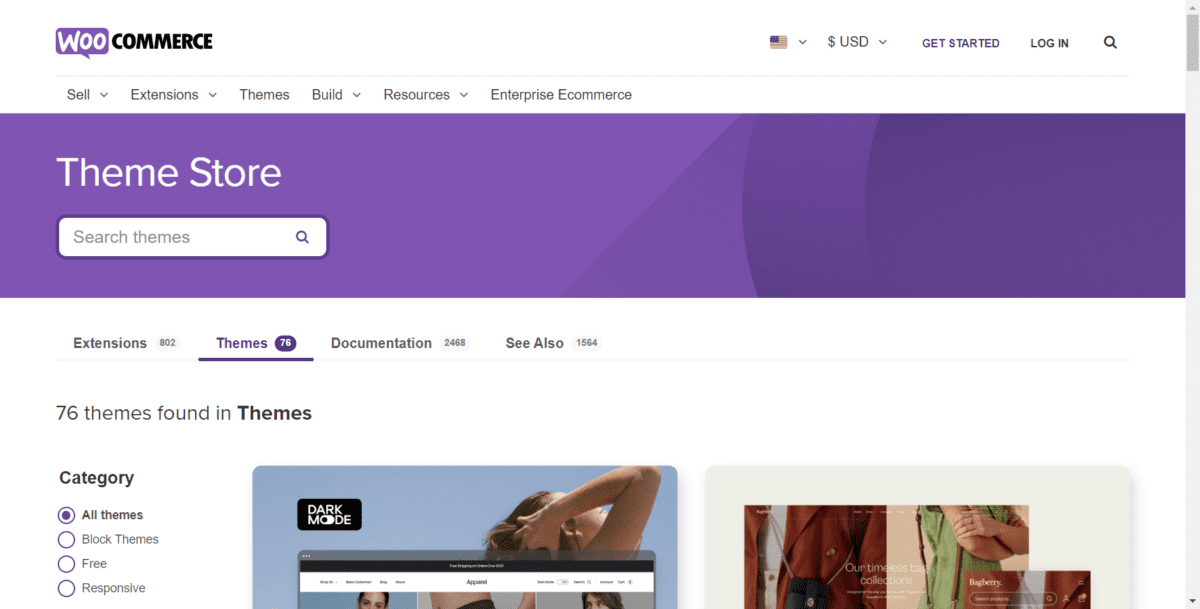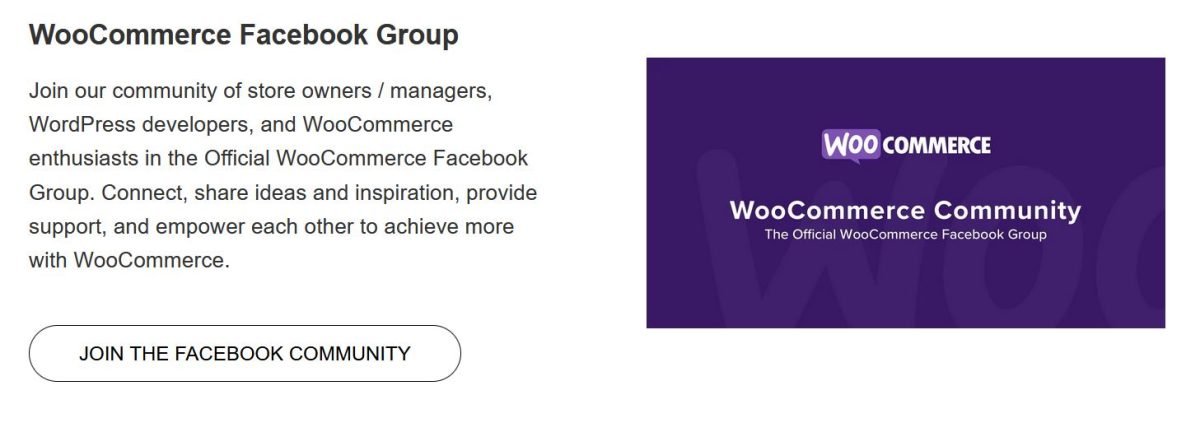I’m a huge advocate of WordPress, but WooCommerce has lagged behind true platforms like BigCommerce, Shopify, and Adobe Commerce. Up until recently, it felt clunky for ecommerce sites, but they have come a long way.
WordPress is King when it comes to content and SEO. I’ve moved my site from Woo to Shopify and back to Woo for SEO purposes. And now there’s enough sales oomph to make it a viable platform.
WooCommerce Overview

Best single platform to run both an ecommerce and an affiliate site under one roof. But the true ecommerce platforms like BigCommerce and Shopify sell better, but not by much. However, choosing it is all about your needs because no platform is fool-proof for every business. Hopefully, after you read my WooCommerce review, you can decide easily.
Pros
- WordPress is the best platform for SEO
- 1-Click Selling App Available
- Lots of WordPress experts available
Cons
- Good hosting can be pricey
- Have to deal with blame game for troubleshooting
- Virtually zero support
- You need extensions for simple stuff
How WooCommerce Platform Compares To Other Popular Platforms
If you’re thinking of using WooCommerce, you can’t really compare it to the simple platforms like Weebly or Squarespace. Those platforms are much more turnkey, beginner-friendly, but very limited.
But the thing is, it doesn’t completely overthrow big platforms like BigCommerce either. Until recently, it felt clunky for ecommerce and has really lagged behind true online store builders like BigCommerce, and Adobe Commerce.
Using WooCommerce is not so straightforward. Since it’s on WordPress, you have to buy hosting, worry about SSL, and purchase a domain name too. Top hosted platforms do not have those issues because all that comes out of the box.
If you’re all for being able to tweak everything on your platform, then it’s great. But without the technical knowledge, you’ll need extra help.
That said, if you’re looking for the best platform for SEO, WordPress is great. It’s also the best if you’re running an ecommerce site and an affiliate store on the same website.
Keep in mind these things before you decide to use WooCommerce and any ecommerce platform:
- Fit with your business model and store size
- Price
- Load time, Mobile and desktop speed
- SEO features
- Advanced marketing features
- Ease of use for you
- Scalability
- UX
In our comparison, I’ve given it a middle-of-the-pack rating.
When it comes to SEO, it’s at the top. It has many decent free themes and amazing features, but it’s not the easiest to use. Plus, you’ll need web hosts to get it on. Good WooCommerce hosting can be pricey, and your cost might skyrocket as a result. There’s also virtually no support with a slow mobile speed.
Some of the many brands using WooCommerce include:
- Entrepreneur Bookstore
- KicksOnFire
- GhostBed
- Rotimatic
- Picky Bars
WooCommerce Pricing
WordPress and WooCommerce are open source software. They’re both free.
It’s not all that pocket-friendly though. The reason is that you’ll need to pay for certain things to run the store.
Woocommerce Features and Plans
The first is hosting. Some web hosts offer plans that are as low as $2, and some go as high as $4,000. Most good hosts offer a free trial or discount for the first year. A hosting worth $2 wouldn’t do anything good for an ecommerce store, except if it is a very simple store. Whatever you choose depends on how much resources you need to run your store.
If you’re a higher traffic site looking to transfer to WP, WPX hosting is a great host capable of handling that. Siteground is my preferred option for beginners.
Then you need to register your domain name. That’s usually around $11 -$15 per year. Some hosts give that free for a year or lifetime as part of their hosting package.
There’s also SSL certificate. You can’t escape that being an ecommerce vendor plus Google would rank sites that have the https string – from SSL – over sites that do not. You might also want to spend on an extra security feature like SiteLock, especially if you’re on a shared server.
Those I’ve mentioned are the costs you can’t run away from. There are other optional things you might want to pay for like themes. You might get a really good free theme that you like…or not. Then you come to extensions.

You’ll need extensions for almost everything. If you only collect credit cards or PayPal payments, you could use payment gateways like Stripe, PayPal, Square, Amazon Pay for free. If you need additional payment options like Authorize.Net, you’ll pay. There are no additional transaction fees from Woo. But other things like shipping rates from carriers, 1-click selling, and follow-up email marketing will cost you.
If you are using one carrier, you have to pay about $79. The USPS shipping plugin, FedEx, and UPS cost that amount. Your cost will go up if you want to use more than one provider. However, you’ll need another extension as well to email tracking info. The Shipment Tracking extension costs $49.
Alternatively, you can use the Shipwire extension for $129. It integrates more than one provider and does the tracking info as well.
The thing is. Most of these things come out of the box on BigCommerce and Shopify. With them, you wouldn’t pay for:
- Web hosting and domain registration
- SSL certificate
- Real-time shipping rates and tracking
- Abandoned cart email
- Product import/export:
The good thing though is that you can get as many bells and whistles as you want. That’s one reason people choose WooCommerce; you match your budget to only the tools you need.
Some people end up spending as low as a $100 or $200 a year. However, it’s possible to overdo it and slap yourself with a $1000 bill or more.
WooCommerce Features
Woocommerce allows unlimited products and product variants. Digital products are included out of the box as well. You can set when and how you want customers to receive them. However, you’ll need to check in with your web host to see if the plan you chose can carry what you want to sell.
Woocommerce Integrations and Plans
It’s easy to add a zoom function, picture gallery, and videos. You can import products from a CSV file, but you’ll need an extension to do so. Marketing features allow you to integrate MailChimp, Klaviyo, and Active Campaign through free apps. User ratings and coupons codes are allowed out of the box
SEO Tools
WooCommerce’s code is optimized for SEO. It is integrated with WordPress.
WordPress has so many SEO features and plugins. Some of them are a flexible URL structure, generate sitemap.xml, canonical URL tags, meta descriptions, and blogs.
The only thing I don’t like is that you need plugins for simple things like meta descriptions. And the more plugins you have on your site, the more security and load time issues you might face.
What I love is the blog. WordPress is a CMS after all. It’s impressive. You can create a new user/author, categorize posts, put tags, optimize images, and the design is intuitive.
In terms of content design and longform page layout, WordPress is ahead of the competition by a mile. You can make pages look really sexy with a page builder like Elementor. Good looking pages are easier to promote and generate links, which is crucial for SEO.
Abandoned Cart Recovery
Shopping cart abandonment is a big problem in ecommerce; visitors often place products in carts, leave the website and never come back it to again. People have other things to worry about.
Abandoned cart recovery is not one of the features of WooCommerce, but you can set it up with Conversio. Aside from its abandoned cart feature, I like that Conversio has a lot of segmentation out of the box. This allows you personalize emails based on location, your relationship with the buyer, those who have invested in your store, and inactive ones. That can increase your conversion by more than 100%.
There are other free and paid apps as well that you can use for more options.
Site Search
If you have a lot of products, your customers will be faced with a slow search or many search results that sometimes aren’t what they are searching for. Sometimes relevant results are mixed with irrelevant ones. Other times, it’s either of those. Fortunately, there are a few extensions that add more relevancy and faster search results.
Real-time Shipping Rates And Tracking
Providing real-time shipping rates is important. If you have a flat fee instead and the actual rate is lower or higher, you’ll lose.
This is one of the places where you pay. I don’t like that you have to pay for this.
WooCommerce allows you to show real-time rates with only paid extensions. Most start out at $79 per shipping carrier. That means if you are using more than one, you’d be paying that times the number you’re using. Or you use a multi-purpose shipping rates plugin. Those are around $200.
It’s not so nice that you have to pay for these things that most true platforms give for free.
WooCommerce Performance
| Platform | Performance | Load Time | Mobile Speed | Desktop Speed | Avg SEO Traffic |
|---|---|---|---|---|---|
| Shopify | 3.9 | 1.3 | 63 | 75 | 11717 |
| Sellfy | 3.1 | 1.4 | 46.8 | 72 | 134 |
| Zyro | 3.3 | 2.1 | 51 | 89 | 128 |
| Nexcess StoreBuilder | 4.0 | 1.93 | 53 | 72 | 58,645 |
| ShopWired | 4.3 | 1.38 | 56 | 80 | 717 |
| Pixpa | 2.3 | 1.6 | 22.66 | 65.5 | 72 |
| Freewebstore | 3.5 | 1.89 | 53 | 79 | 927 |
| Ecwid | 3.5 | 5.0 | 50 | 82 | 15,517 |
| Square Online | 2.8 | 2.03 | 1.0 | 3.0 | 65,317 |
| BigCommerce | 4.5 | 2.2 | 63 | 80 | 33626 |
| Woocommerce | 3.1 | 3.4 | 42 | 52 | 72968 |
| Shift4Shop | 3.0 | 2.8 | 50 | 58 | 9703 |
| Volusion | 2.9 | 3.5 | 48 | 56 | 15779 |
| Adobe Commerce | 2.8 | 4.8 | 39 | 43 | 19408 |
| Prestashop | 2.9 | 4.62 | 50 | 52 | 33851 |
| SquareSpace | 3.5 | 3.5 | 42 | 63 | 5678 |
| Wix | 3.9 | 3.2 | 69 | 81 | 543 |
| Weebly | 2.6 | 3 | 49 | 59 | 186 |
Time is money. People are too impatient to wait for your site to load or scroll down to the 7th SERP. Every second your site takes to load, and lack of good ranking will cost you a lot.
Hosted platforms like BigCommerce and Shopify are optimized by the company. You don’t do much when it comes to load time, and most vendors are not complaining. Customers want sites to load in 3 seconds or less, and those two take the cake with 2 – 2.5 seconds on BigCommerce sites and under 2 seconds for Shopify stores.
WooCommerce sites, on the other hand, tend to load in 3.4 seconds. Optimizing load time in WP is up to you and the hosting plan you’re on. You need to spend time and money to get the best, but most WP sites owners don’t bother.
Another bad part is that these sites fall below the average for mobile speed score. Mobile users expect your site to load faster over desktop. With more people ending purchases on their mobile devices, your mobile speed needs to be fast. The average is 51.5/100 and WP is at 42. The desktop speed is also below average.
The default WP with WOO “out of the box” is not totally SEO friendly. Sure, you can do bulk editing and customize your URLs and permalink, but for the most part, you’ll need plugins.
There are many that you can use without paying a dime. You can customize meta description and keywords with SEOPress, All in One SEO, and the host of other plugins. Some of those plugins generate XML sitemap. Many WP themes like Neighborhood by SwiftIdeas have the metadata feature as well.
With those functionalities, as long as you grind hard, you’ll shine hard. Woo sites are dominating Ecommerce SEO with an almost 400% increase than the average organic traffic score. Shopify is below the average by about 50%.
WooCommerce Extensions and Apps
So far, I mentioned many times how you can use plugins and extensions to expand the functionality of your Woo site. Some of those extensions make Woo top some of the hosted platforms. For example, you can turn your store into a subscription-based business for $199 which is cost effective compared to Shopify’s $39.99/month.
There are some WooCommerce products that are free – Amazon 2-way sync for example. But you’ll pay for a lot of basic stuff. I hate that you need to use an extension for the simple stuff.
For example, on Bigcommerce, you get real-time shipping rates and tracking numbers out of the box. This is a basic ecommerce functionality for any store selling physical products. But WooCommerce doesn’t have it.
You have to pay to calculate real-time shipping and add tracking numbers to orders.
Integrating FBA Is Impossible
For years, the official app for connecting your store to FBA for packing and shipping worked fine. Then last year, Amazon stopped it and after some back and forth, the agreement was that WooCommerce store owners would have to use the developers’ credentials to connect to Amazon.
The process is not so long, but it seems it’s still being worked on because you can’t buy the extension right now, either on the extension store or the developers’ site.
One more thing. If you’re outside North America, you can’t use it – that’s for when it finally becomes available. No one has found a better alternative as of yet.
Multi-Channel Is Great
You can bank on WooCommerce when it comes to syncing your shop with Amazon, eBay, and social media sites like Facebook. You can manage your channels from your WordPress dashboard with free extensions that are certified by the platform for that. However, selling on Google, it will cost you.
You Pay For 1-Click Upsell
While it’s not a must-have for ecommerce; it’s still important. According to Accessally, 1-click upsells lifts revenue by up to 35%. It’s a proven sales strategy.

Although Woo is amazing with upselling and cross-selling, it left out 1-click upsells. The flaw is that you’ve to pay for it. There are some options in the extension store, such as UpStroke One Click Upsells by WooFunnels with plans starting at 99/year.
I mentioned some of the apps that you can use to cover some of Woo’s missing features, like marketing automation, abandoned carts, etc. You might want to check out:
- Conversio
- Jilt
- Amazon and eBay Integration for WooCommerce
- WooCommerce Dropshipping
- WooCommerce Product Reviews Pro
- Google Product Review Feed for Google Shopping Ads
- WooFunnels Products (AeroCheckout, UpStroke, OrderBump)
WooCommerce Themes and Design
WooCommerce themes and design is one place you’d see it being on top of the charts among the top ecommerce platforms. In our research, they topped the average score of 4.0 – scoring 4.3.
There are over 1000 free WordPress themes that are compatible with WooCommerce. There’s a lot of flexibility, and you can even build your own or customize what you get with child themes.
One theme that’s great for ecommerce is Astra/Astra Pro. When combined with Elementor, there’s a lot of flexibility to customize without code. You can design anything you want because Elementor has page templates and drag and drop functionality that’s compatible with Woo. You wouldn’t need a dev.
You also have the option to use any of WooCommerce StoreFront themes, or any other paid theme on the web.

Although WP themes are beautiful, many fall short of being modern designs. But, they look amazing on mobile with a great mobile UX rating, score, and a mobile-friendly percent of 98/100.
Watch out when choosing a theme though because there are some crappy ones as well. That’s largely because WP is open source so every Tom, Dick, and Jane who knows how to code might design a theme.
| Platform | Design & Themes | Visual Design | Mobile UX | Cost Of Premium Themes | # of Free Themes |
|---|---|---|---|---|---|
| Shopify | 4.0 | 5.0 | 97 | $140 | 9 |
| Sellfy | 5.0 | 5 | 93 | $0 | 5 |
| Zyro | 5.0 | 5.0 | 92 | $0 | 50+ |
| Nexcess StoreBuilder | 4.3 | 3.0 | 94 | $20-$100 | 4 |
| ShopWired | 4.3 | 5 | 93 | $3495+ | 20 |
| Pixpa | 4.3 | 5 | 94 | 0 | 131 |
| Freewebstore | 4.3 | 5 | 92 | 0 | 100+ |
| Ecwid | 4.3 | 5.0 | 93 | $60 | 1 |
| Square Online | 3.7 | 5.0 | 92 | $0 | 1 |
| BigCommerce | 3.8 | 5.0 | 94 | $150 | 12 |
| Woocommerce | 4.3 | 3.0 | 97 | $39 | 1000+ |
| Shift4Shop | 4.3 | 4.0 | 95 | $200+ | 50+ |
| Volusion | 3.7 | 4 | 92 | $180 | 18 |
| Adobe Commerce | 3.7 | 5.0 | 5 | $300+ | 1 |
| Prestashop | 3.2 | 4 | 94 | $29+ | 0 |
| SquareSpace | 4.3 | 5.0 | 5 | 100.00% | 14 |
| Wix | 4.7 | 5.0 | 92 | 0 | 72 |
| Weebly | 4.3 | 5 | 97 | $45 | 15 |
Ease Of Use
| Platform | Ease of Use | Phone Support | 24/7 Support | Chat Support | Community Rating | # of Apps/ Plugins |
|---|---|---|---|---|---|---|
| Shopify | 4.9 | Yes | Yes | Yes | 5 | 5,000 |
| Sellfy | 3.5 | No | Yes | No | 4 | 4 |
| Zyro | 3.7 | No | Yes | Yes | 4.7 | 30 |
| Nexcess StoreBuilder | 4.5 | Yes | Yes | Yes | 3.6 | 50,000+ |
| ShopWired | 4.5 | No | No | Yes | 4.9 | 72 |
| Pixpa | 3.7 | Yes | No | Yes | 4.7 | 103 |
| Freewebstore | 3.4 | No | No | Yes | None | 25+ |
| Ecwid | 3.6 | 5.0 | 1.0 | 5.0 | 4.7 | 100+ |
| Square Online | 4.0 | 5.0 | 1.0 | 5.0 | 4.2 | 25+ |
| BigCommerce | 4.8 | Yes | Yes | Yes | 4.0 | 1000 |
| Woocommerce | 3.3 | No | No | Yes | 4.0 | 250+ |
| Shift4Shop | 4.3 | Yes | Yes | Yes | 3.0 | ~250 |
| Volusion | 4.1 | Yes | Yes | Yes | 2 | ~20 |
| Adobe Commerce | 2.2 | No | No | No | 4 | 3000+ |
| Prestashop | 2.9 | Yes | No | No | 3 | 3000+ |
| SquareSpace | 3.8 | No | Yes | Yes | 3.0 | 10+ |
| Wix | 4.2 | Yes | Yes | No | 4.5 | 700 |
| Weebly | 3.6 | Yes | No | Yes | 2 | ~350 |
WooCommerce falls short in ease of use – only passing Wix at a 2.7. That’s low where BigCommerce is 4.7 and 3dCart is 4.1.
If you aren’t familiar with WP, you’ll struggle with WooCommerce. Setting up WP, themes, and plugins require a bit of technical knowledge. Until you pass that roadblock, you’ll need to train yourself a bit. WooCommerce offers some tutorials that might help. YouTube and other online video sources are there as well. You can also use our WordPress guide.
If you’d rather drop all the hassle it takes to set it up and manage yourself, you can get developers. WP is friendly for them. WooCommerce displays the link to some developers’ GitHub profile on their site, so you don’t need to go too far to search for one.
There are fewer apps and plugins available with WooCommerce than there are with Shopify or Bigcommerce. But I’ve found that it rates high for features and functionality.
One major reason for WooCommerce low ease-of-use score is their lack of direct customer support. No phone support. That’s normal for open source platforms – Adobe Commerce doesn’t have them as well.
You can create a ticket, and they occasionally respond – you might not want to wait. Plus, if you’re using non-Woo products on your store, they might ask you to disable them before they can provide support.
There is a community forum though. The quality of response you get there varies. Sometimes you might not get a response. Other Times, you might get a relevant response almost immediately, or wait for more than 48 hours.

WooCommerce Alternatives
If after reading this review, WooCommerce seems too much for you, there are many other alternatives to choose from. If you’re willing to go for a hosted ecommerce platform, BigCommerce and Shopify are great alternatives. If you’d rather stick with buying hosting, then the self-hosted version of PrestaShop is a nice alternative, just not as good as WordPress though.
- BigCommerce
- Shopify
- PrestaShop
BigCommerce
Almost every type of business does well on BigCommerce. Be it a simple store, startup, or large business. Regardless of the number of orders you get, your site doesn’t slow down unlike what happens at the admin area of WooCommerce. For performance, it’s better – a faster load time, mobile and desktop speed.
For beginners or those not willing to spend on developers, when it comes to BigCommerce vs WooCommerce, specialty platforms like WooCommerce may be the right option. You don’t need any technical skills. All you do is choose a plan, and use the in-depth editor. You also get things like real-time shipping rates free and abandoned cart as part of the top tier plan. However, there is no upselling or cross-selling, and you can’t offer 1-click upsell. And, you end up paying anything between $29.95 to $249.95 every month against WooCommerce free download + hosting price.
Shopify
Shopify works well for beginners; you can drag and drop your designs. Also, you don’t deal with web hosting.
It’s ideal for drop shipping because of the free integrations it has with dropshipping tools like Spocket.
Their themes have better modern design rating as well. It greatly expands on integrations, making it possible for you to sync your store with Amazon and eBay without any app. FBA is also a big part of it, unlike WooCommerce where that is impossible. Keep in mind though that their SEO is shaky, you pay additional transaction fees, and their premium themes are more expensive.
PrestaShop
PrestaShop seems to be able to handle most things that WooCommerce does. And more. It is an ecommerce CMS while Woo is a plugin. That’s specialization which should bring many goodies but a lot of integrations are paid and quite expensive. If you wanted to start a loyalty/ customer reward program, show customer reviews, sell on multiple channels or social media, your cost will add up.
The areas that it tops Woocommerce are a robust product search functionality and abandoned cart email feature.
Finally, if you want to sell digital products like courses or membership, check this list.
WooCommerce Review Wrap Up
WooCommerce is the best single platform for people who want to run an ecommerce and affiliate site under one roof. It’s ideal for using content to drive traffic to products or Amazon affiliate offers. The content management functionality and SEO tools make that possible.
It also does a great job with small and medium-sized ecommerce stores with many features integrations and apps. However, large ecommerce stores may want to stick with BigCommerce; better performance (both front end and admin), and more integrations to support the store are some of my reasons for choosing it.
I hope my WooCommerce review helped in your decision process. If you have any questions, send a comment. To get started with WooCommerce, click here












